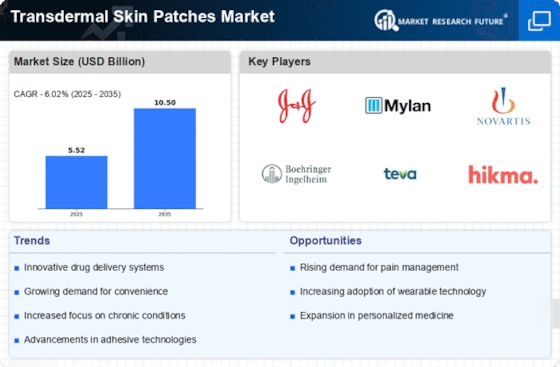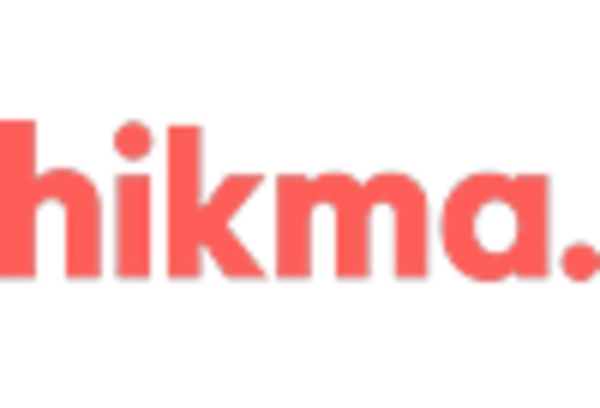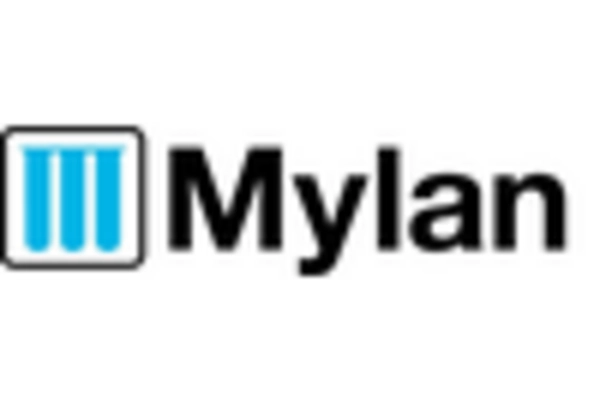Rising Demand for Personalized Medicine
The Transdermal Skin Patches Market is witnessing a notable shift towards personalized medicine, which is reshaping drug delivery methods. As healthcare moves towards tailored therapies, transdermal patches offer the flexibility to customize dosages and delivery rates based on individual patient needs. This trend is particularly relevant in chronic disease management, where personalized approaches can significantly enhance treatment efficacy. Market analysts suggest that the demand for personalized medicine is expected to grow, driven by advancements in genomics and biotechnology. Consequently, the transdermal patch segment is likely to benefit from this trend, as it aligns with the broader movement towards individualized healthcare solutions.
Increasing Prevalence of Chronic Diseases
The rising incidence of chronic diseases such as diabetes, hypertension, and pain management conditions is a significant driver for the Transdermal Skin Patches Market. As healthcare systems strive to manage these conditions more effectively, transdermal patches offer a convenient and effective alternative to oral medications. According to recent estimates, the prevalence of diabetes alone is projected to reach 700 million by 2045, creating a substantial demand for innovative delivery systems. This trend is further supported by the aging population, which is more susceptible to chronic ailments. Consequently, the market for transdermal patches is likely to expand as healthcare providers seek efficient solutions to improve patient outcomes.
Regulatory Support for Transdermal Technologies
Regulatory bodies are increasingly recognizing the potential of transdermal technologies, which is fostering growth in the Transdermal Skin Patches Market. Supportive regulations and streamlined approval processes for new transdermal products are encouraging manufacturers to invest in research and development. This regulatory environment not only facilitates the introduction of innovative products but also enhances market confidence among stakeholders. As a result, the number of approved transdermal patches is on the rise, which could lead to increased competition and a broader range of options for consumers. This supportive framework is likely to play a crucial role in the market's expansion in the coming years.
Growing Preference for Non-Invasive Treatment Options
The Transdermal Skin Patches Market is benefiting from a growing preference for non-invasive treatment options among patients and healthcare providers. Non-invasive therapies are perceived as safer and more comfortable compared to traditional methods, such as injections or oral medications. This shift in patient preference is particularly evident in the management of pain and hormone replacement therapies, where transdermal patches provide a discreet and user-friendly alternative. Market data indicates that the non-invasive drug delivery segment is expected to witness substantial growth, driven by increasing awareness and acceptance of transdermal systems. This trend is likely to propel the market forward as more patients opt for these innovative solutions.
Technological Innovations in Transdermal Skin Patches
The Transdermal Skin Patches Market is experiencing a surge in technological innovations that enhance drug delivery systems. Advanced materials and micro-needling techniques are being developed to improve the efficacy and absorption rates of medications. For instance, the integration of nanotechnology into patch design allows for more precise dosing and targeted delivery, which could potentially increase patient compliance. Furthermore, the emergence of smart patches equipped with sensors for real-time monitoring of drug levels is likely to revolutionize patient care. This technological evolution not only addresses the limitations of traditional drug delivery methods but also aligns with the growing trend towards personalized medicine, thereby expanding the market's potential.


















Leave a Comment